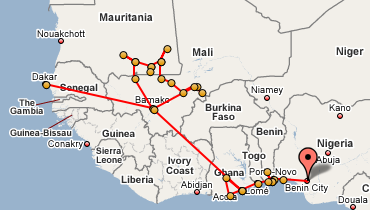
I stayed at the Lixborr Hotel in Benin City, Nigeria. When I arrived, I asked the rate while a taxi driver waited patiently outside. Confirming the rate at the reception desk, I went back to the taxi and got my bags. Then, returning to reception, the same receptionist told me a different rate because they had no rooms at the rate she quoted me. Discussing this for half and hour produced no result except my sitting and waiting, exhausted by travel, in the lobby for the manager. The manager agreed to split the difference between the quoted rate and the actual rate until they could move me into a room at the rate reception had originally quoted me. I agreed so I could get into a room! Who licks boars, or is it bores, anyway? The hotel has a bar frequented by younger Nigerians who like to drink. The restaurant is usually empty and connected to the bar. There are two nice sculptures out in front of the hotel and it is located just across the street from the brass casters quarter.
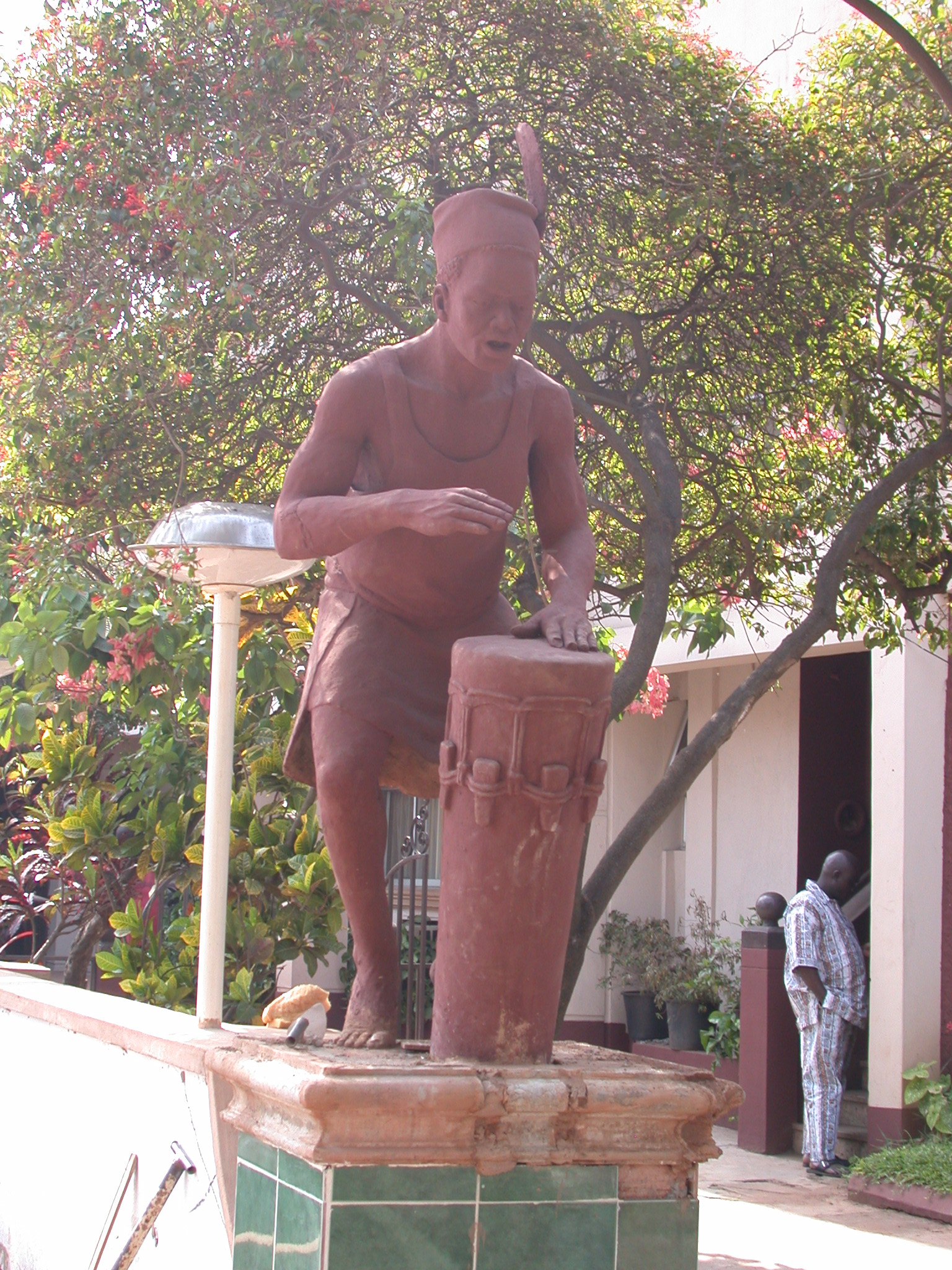
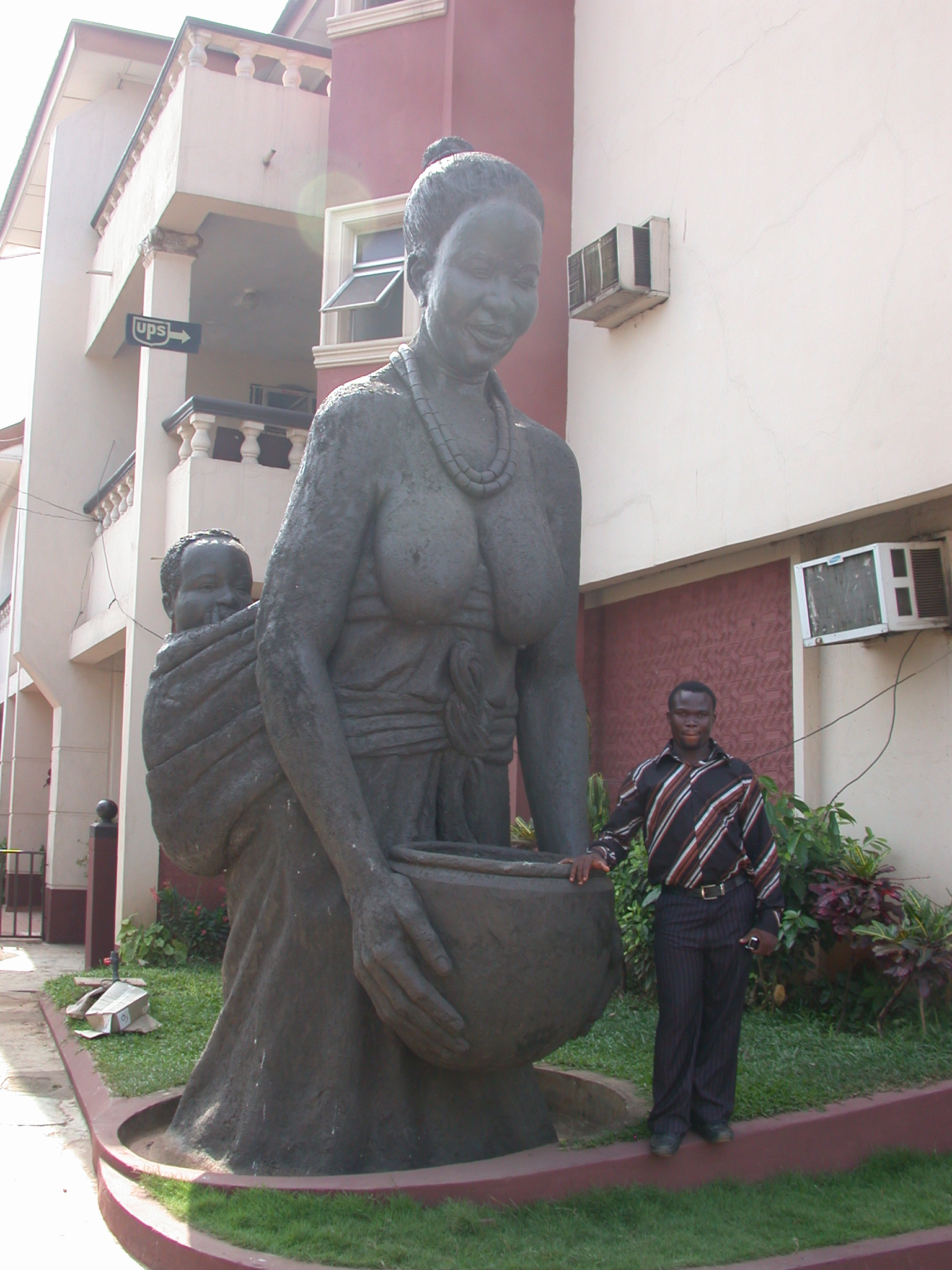
The last picture includes a friend I made in Benin City… he’s the son of one of the local chiefs who showed me around town a bit. I’m not sure exactly where I took this next picture of the Asoro statue.
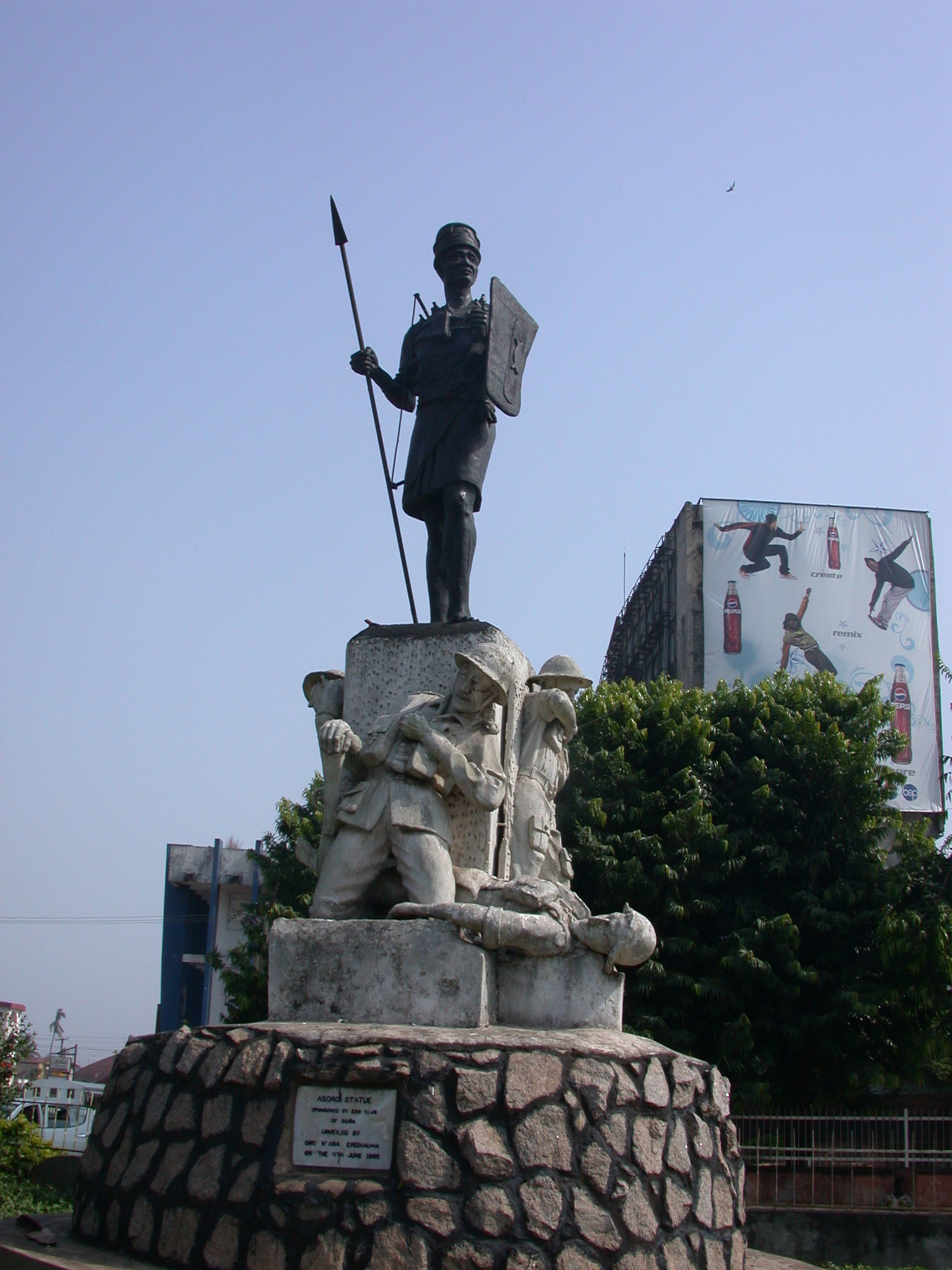
The Benin National Museum is located at King’s Square in the center of the Ring Road, making it quite a traffic hazard to try to walk to the museum entrance.
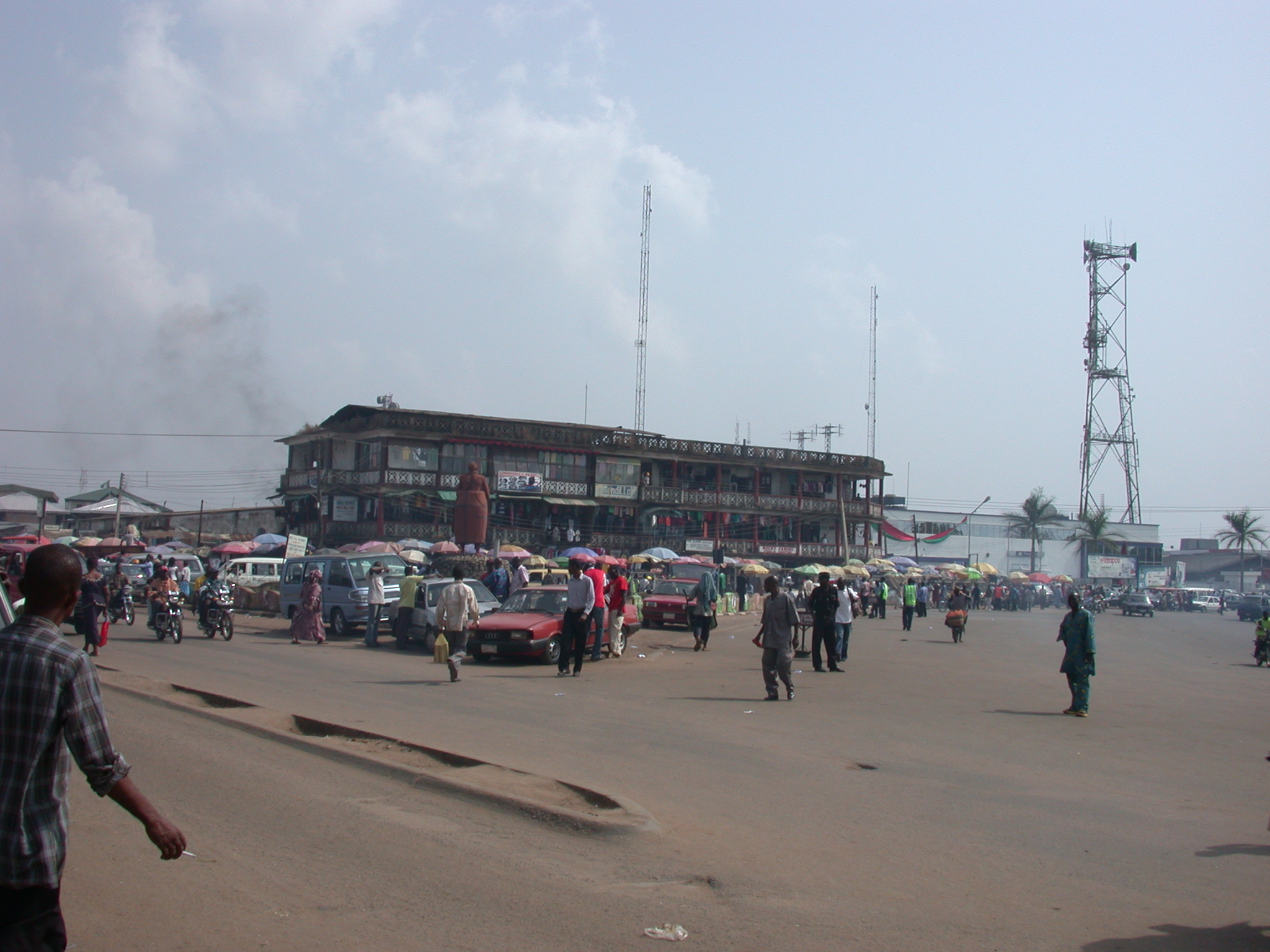
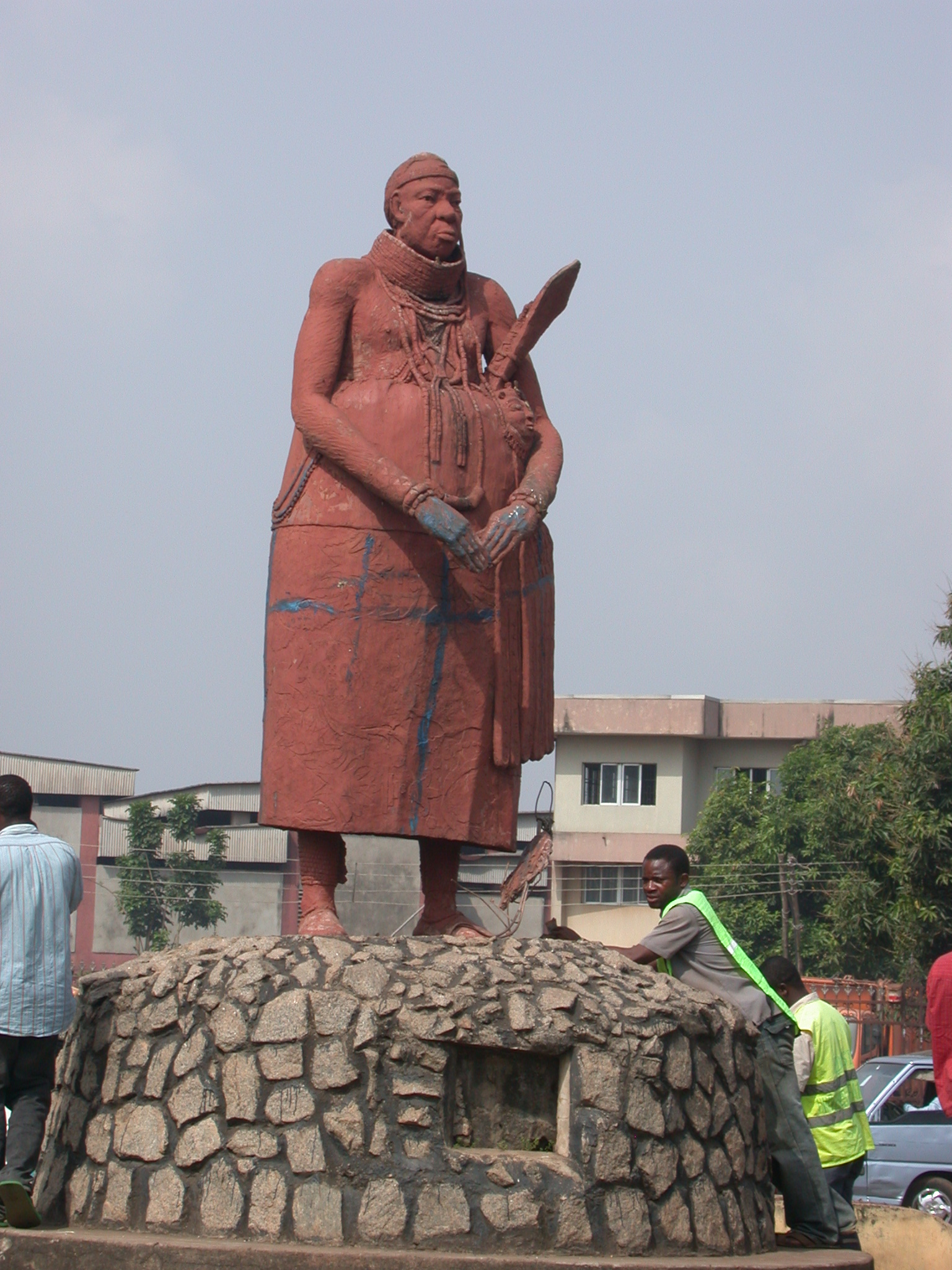
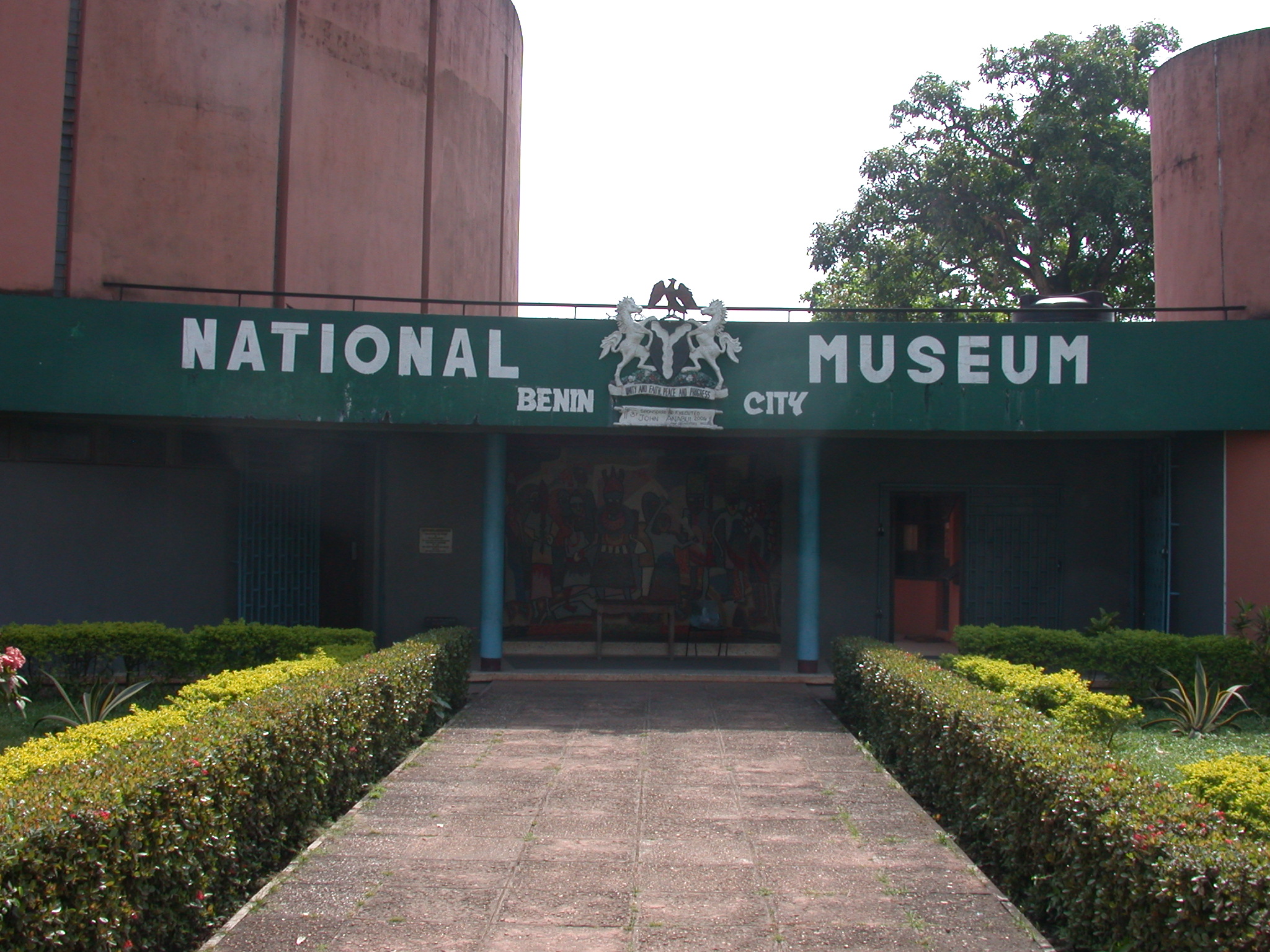
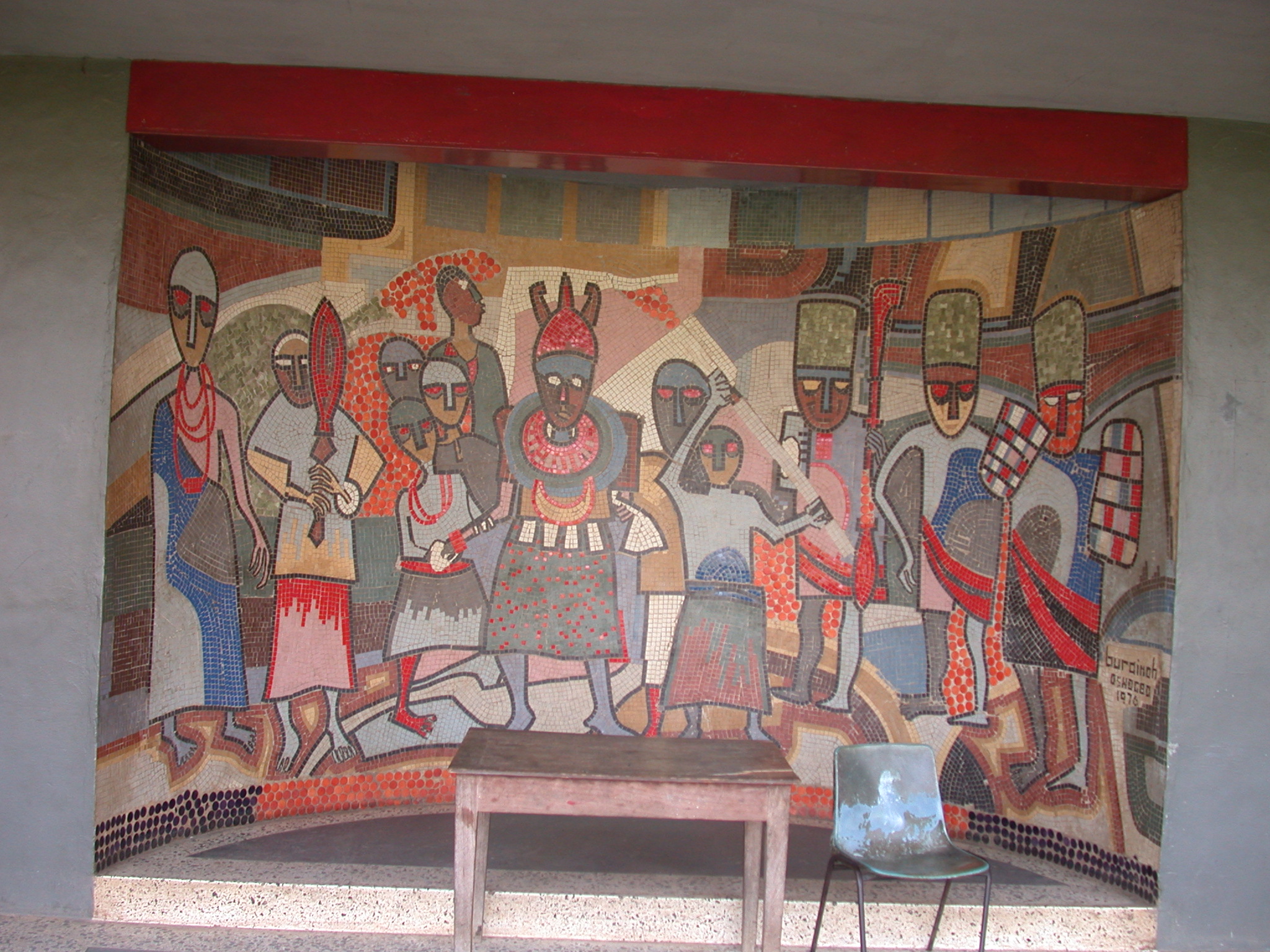
I had a bit of a snit with a guy sitting in the parking lot about whether I could take pictures outside the museum. Eventually, I got to chat with the museum director who assured me that, even though the museum did not permit pictures of the artifacts inside the museum due to people creating duplicates to replace with the originals they would steal, taking pictures outside the museum was OK. Whew! I waited a half hour to purchase an entry ticket for the museum.
DOWNSTAIRS–
Case 20:
Equestrian figure with shield and axe (bronze)
Horse rider – barrel-shaped stomach and torso, diminutive hands, necklace with motif (see journal drawing), cap with floppy top, three scars or wrinkles on each side of mouth
Medicine container, three legs, face below spout
Portuguese soldier who helped Oba Esige in war against the Idah
Case 19:
Terracotta heads for bronze casters to place on their paternal shrines
Case 18:
Igbesamwan guild:
Carved wooden bowl with knot pattern (see journal drawing)
Carved wooden antelope box
Case 21:
Iguneromwon guild made bronzes for oba:
Decorated bronze gong used by oba, three figurines, oba in center, his hands held on each side by other figures
Bronze ram pendant – chief’s ceremonial paraphernalia
Bronze baboon hip mask – chief’s ceremonial paraphernalia
Bronze fish-styled kolanut container used for royal visitors
Case 17:
Ivory carvers same guild as wood carvers
Ivory equestrian figures
When elephant killed, one tusk for oba plus he had first option to buy the other tusk in the pair
Case 16:
Egogo – double bronze gong used by oba to scare away evil spirits
Bini warlord with assistants, bronze plaque (photo)
Case 15:
Bronze plaque depicting war chief holding ceremonial sword in right hand, cap or helmet, feather (?) above left ear, gong (?) under left hand
Bronze plaque of commander-in-chief of Bini army and his diminutive horn blower
City of Benin, center of kingdom, oba’s palace
Two parts: Ogber oba’s residence, court, palace chiefs
Orenskhua – town chiefs’ and retainers’ homes
Further divided into 40+ wards, each ward specializing in duties for the oba, such as brass-casting, leatherwork, etc.
Queen mother in separate palace outside city walls
Case 23:
Bronze equestrian figure – messenger from the north, muzzle and strange reins and harness (?) or blades (?) in each hand, elaborate headdress including pine cone like shape on top
Case 14:
Bronze Ododua ceremonial head mask worn by seven dancers during Igue festival, oval mouth, two bronze braids of hair of fiber hanging in front of ears on each side, elaborate headdress looking like half wheel with spokes
Bini pendant depicting magical power – lion-like face, oval mouth, circular rings around edge
Case 24:
Partial reconstruction of shrine (one of two) in oba’s palace to commemorate his ancestors – sacrifices made here, bells, staffs, carved ivory tusks mounted on bronze heads, bronze heads and other bronzes, floor has cowrie patterns set in clay/earth
Carved ancestral heads
Iye, big bronze cock, locally called “Okpa�?, usually on altar dedicated to queen mother
Case 25:
Oro – Bini bird of disaster symbolizing oba’s superiority over fate, bird with long narrow beak on pedestal
Bronze hip mask of a queen mother
Bronze bust of a Bini oba – young-looking, helmet with three protruding elements left, center, right, braids/fibers hanging from helmet or head hair(?), ringed necklaces on neck and draped on chest
Case 26:
Aomuada – nude royal attendants, three standing side by side with layer hair/helmets, braids/fibers on each side in front of ears, elaborate designs on bodies (diamonds, triangles, circles), bracelets, anklets, uncircumcised phalluses
Bronze mudfish plaque
Case 27:
Ibebogo – bronze altar of the hand, symbol of human power to achieve mateial and practical success, oba’s hand = well-being of whole kingdom, cylinder shape on thin base, cnetral male oba’s figure, accompanied by female figures with drooping breasts, fans(?) covering genitals (holding hands on each side), knotted patterns in circles on cylinder top
Case 28:
Brass plaque for ritual sacrifice of cow – four figures holding stretched legs, another holding head while main figure slits throat with dagger, two other small and even smaller figures holding ceremonial objects(?), one figure holding leg may have bald pate on top suggesting layers, represent hair rather than helmets, another has braids of hair or fiber braided into hair(?)
Note: “Braids�? could also be strings of beads hanging from beaded crown
Executioner’s head – strange longish shape with “nose�? six inches up from handle
Case 29:
Janus executioner with each side holding sword on right and severed head in left hand
Single executioner, sword in right hand, severed head in left
Body of executed victim, face down, elbows bound together with twine behind back
Case 30:
Bronze ritual jug in shape of leopard used to pour water from mouth or nostrils to cleanse oba’s hands during ceremonies, filled through hole in top of head
Bronze spoon used in ceremonies
Case 31:
Bronze plaque of oba in divine aspect supported by attendants holding one hand on each side, all wearing helmets with protruding pole topped by four horizontal radial spikes and one vertical spike, neck rings, tunic, braids, belt or kilt with human heads, legs of mudfish, four frogs around border of patterned background with three arms (left, bottom center, right) holding three feathers each, mudfish-legged oba equated with olokun, god of sea OR possibly an oba who became paralyzed
Another similar plaque
Ekpen (Edo) bronze leopard wall mask used for decoration of paternal shrines
Obas were divine kings, reincarnations of past kings, whose health was equated with the well-being of the kingdom, person of the king was sacred, had supernatural powers
Case 34:
Bronze plaque representing oba Akengo I, a Bini king who had dreadlock (dada) hair, holding sword in right hand, necklace, kilt
Case 35:
Bronze plaque of Benin king, dressed in regalia: staff of office, shield, neck rings, four attendants
Miles on miles of Benin City walls, inner wall 45 (or 4.5?) feet high, dated to 1450-1550, deep ditch running on outside
Case 1:
Bronze cast of queen mother’s head in early 16th century, Idia-Ghe, mother of Oba Esigie, played important role in war against Idahs, so Esigie gave her title of queen mother (the first one), neck rings, conical hat or hair netting pointed toward direction forward from face, four braids on each side in front of ears
Another queen mother head
15th-16th century, empire reached from Porto Novo to beyond Niger River in east, vassal states paid tribute to oba or faced war
Spears, rather short, of iron
Short guns introduced by Portuguese
Ukokoghe (Bini) gun powder keg used to store gunpowder or traditional medicines, shaped like a big long pill with hole at top, face in middle, and rings on each side
Riches of Benin court hidded from outside world until British expedition of 1897.
1485 – Europeans first got word of Benin, trade in peper, ivory, slaves, palm oil
1668 book has picture of oba being carried
1897 foreign visitor’s map of Benin
Bronze plaques of Portuguese warriors, some holding manilas, which succeeded cowries/shells as currency in 16th century
Portuguese assisted Oba Esigie in war against Idah
Pair of bronze rams used as security agents in oba’s palace
Ceremonial swords used as sanctions of chieftanship deriving from oba and as symbols of his own kingship:
Ada (drawing in journal)
Eben (drawing in journal) – dances of homage to oba danced with Eben before chiefs
Equestrian figure of oba with attendants demonstrates oba’s social control over man and beast
Ofo – messenger of Ogiuwu – chief in charge of all executioners, presentation of bronze plaque signifies death sentence, head with diminutive legs, bent arms sticking out from top of head, four radial circular emblems in relief from background with dotted and floral design
Royal messenger wearing Maltese cross on chest
1897 palace took up 1/16 of city – entered palace through gate flanked by high towers, large bronze python (40 foot long) mounted on each tower, undecorated clay wall surrounding palace, interior richly ornamented, interior building surrounded series of courtyards, behind three courtyards was a large conference hall with huge bronze snake at southern end
Plaque of Amufi acrobats hanging on ropes from cotton tree with three birds in upper branches, ceremony to bring rain
Case 38:
Bronze plaque of crocodile with fish in mouth (not mudfish), best sacrificial victim to Olokun, goddess of the sea, is the crocodile
Benin Court art – according to Chief Eghareuba, brass casting began in Benin City in 1280 when Oba Oguola commissioned Iguegha to found a guild of skilled craftsmen (Iguneromwon) – worked solely for oba’s court, altarpieces, plaques, decorative objects
Iguneromwon in one city ward and other wards included guilds that didn’t have to work only for the oba:
Igbesamulan: wood and ivory carvers
Isseivie: beadworkers
Ise-Ekpokie: leather workers, etc.
UPSTAIRS–
Case 1:
Okakagbe Masquerade – role of spirits to the living
Odagu mother figure masquerade is senior figure in Okakagbe dance from Etsoko division at annual festivals held by Weppa-Wano at New Yam time (Oct-Mar) or to honor village titulary deity, four adults and one child in this dance
Case 2:
Carved ivory amulets, figures of oba, chiefs, musicians, or abstract designs
Chiefs used wooden carved rams heads in ancestral shrines since bronze only for oba
Pair of stools sent by Oba of Benin to King of Portugal
Case 3:
Ewawa divination used ram horns, bronze cover with human face, pendants, and cowrie charms
Ifa divination pendants – all pendants have oval shaped metal pieces on thin twisted metal sticks
Case 4:
Carved wooden ancestral head with feather
Case 5:
Olokun (male) shrines with elaborate clay pots, divinity of sea and rivers, mainly worshiped by women who have individual shrines for him
Ikengobo (wooden), used in cult of the hand, symbol of individual’s efficiency and success
“Akhe�? Osun pot used to hold traditional medicines
Case 6:
Ekpo face masks (five) performed with raffia in masquerades on yearly Eho Ekpo ritual celebrating the young and healthy, masked dance on final day of ritual, senior mask is Iyekpo, epitome of motherhood, other masks: native doctor, authorities, and animals, especially leopards, antelopes, and young people
Case 7:
Traditional drums used by native doctors and chiefs during ceremonies, four foot tall, wooden with carved figures and designs, pegged skins on top
Case 8:
Pottery, fashioned by hand (no wheel), prepared by pounding, kneading, treading, mold or coil lumps of clay on supporting device like calabash, dried in sun then fired before or after decoration, firing in open or in low wall enclosure (but no true kiln), stacked on leaves, twigs, cow dung under heap of grass, 15 minutes to whole day in duration, some only sun dried
Case 9:
Palace wooden door panels
Case 10:
Headdresses from Delta state – stilt dancers
Case 11:
Wooden helmet possibly from Afema division (beautiful!)
Case 12:
Musical instruments:
Aktapa (stringed above wooden box), hano? Used during folktales
Snake skin twin drums (double membrane), used by native doctors
Ivory flutes
Finger piano (metal slats over wooden box with small hole)
Case 13:
Carved wooden box used by princess or presented to her during marriage ceremony, knotted pattern (see journal drawing) and other knots on top, radial and knotted patterns on sides
Case 14:
Wooden container for pounding yams (like large wooden goblet with lid)
Wooden combs
Tray used to carry palm wine usually in calabash bowl
Wooden tray
Wooden figures to offer kolanuts
Igara cloth (looks almost like Tellum design)
Case 15:
Long wooden pipe (six feet) with bowl lit by small child who sits by the end
Oguoro game board
Ayo played with beans, counters, or cowries
Case 16:
Wooden royal “telegraphic�? stool – sent as if a letter, message in design of stool
Case 17?:
Terracotta head used for decoration and remembrance
Case 18:
Cast of head in Udo style
Case 19:
Ife terracotta head placed in paternal shrine
Case 20:
Bronze Janus head used as part of Obuobo bell in ancestral shrine, etc.
Case 21:
Some similarities between Benin, Delta, Ife, and Owo styles, for example striations on some Owo terracotta and Benin bronze faces
TOP FLOOR–
Nigerian traditional cultures:
Igbo: democratic, egalitarian
Yoruba: patrilineage
Bini: divine ancestral kinship
Emirate system in northern Nigeria
Iron, mid 7th century BCE in central Nigeria
Terracotta, 500 BCE, Nok
Divination
Yoruba
Shango, thunder (parallel to Igbo’s Amadioha)
Eshu, trickster
Ifa priests (Dibio priests of Igbo – Afa divination) (Edo’s Ewawa)
Odu-Iwa divination narratives, 256 verses
Babalawo trained for 5-10 years to be father of secrets
Number system based on 20 (see Goutier Hegel, 1996)
Rainmakers burn large wood fires to create precipitation
Right hand symbol of strength and achievement among Igbo, Igala, Urhobo, and Edo in the Ikenga complex
Hero worship of skull, fertility or ancestral cult symbolized in Ekpa wooden sculptures (Oron – Cross River), So, and Mimuye figures (Adamawa/Taraba)
Ibeji twin figures (Ere Ibeji) – Yoruba redefinition of what elsewhere was considered an abomination, tied to concept of reincarnation and repeater babies (Abiku or Ogbanjo in Igbo)
Case 1:
Divination:
Beaded Ifo divination bag (apo ifa)
House whisk (irukere ifa)
Large beaded divination charm (ileke ifa)
Beaded divining chain (opele ifa)
Divination tray (opon ifa)
Divination ivory (iroke ifa) used to invoke Orunmila
Receptacle (ogere ifa)
Case 2:
Sango (Yoruba)
Wooden double-headed axe (ose sango) {Aam dioha (Igbo) – check this}
Ritual garment (ewu sango)
Ritual wand (ose)
Receptacle (arugba sango)
Sango staff (ose)
Ritual mortar (odo sango)
Case 3:
Esu Elegbara – trickster god, Orunmila’s companion, messenger of the gods (Yoruba) or gatekeeper (Benin)
Edo variant of Ifa called Ewawa in Benin, using bundle of charms
Case 4:
Ram head symbolism
Owo piece called Osama sinmi (variant of Benin Uhumwelao memorial heads in ancestral shrines)
Case 5?:
Panel I: Cult of Hand
Panel I(A): Art of Honoring the Dead
Panel II: Heroes and Heroines
Human flutist with semi-erect phallus and protruding bellybutton from Montol, Plateau states
So figures – Mambila / Adamawa
Case 5: Motherhood
Ibesi twins
Bay 2:
Music
Hausa/Fulani: string and wind experts
Yoruba: talking drums
Igbo: xylophones, thumb pianos
British learned Yoruba drum signals (Basden, 1921, p.364)
Gelede masks of SW Yoruba and Dahomey, worn by men masquerading as women in honor of the great Mo?____a?_Nea (?) whose witchcraft powers are cultivated in rituals, dance, and drama to enhance fertility
Drums
Ogere slit drum (Igbo) used as talking drum
Case 6:
Resonators:
Ankle rattles, waist rattles
Calabash
Ivory flute (inc. Yoruba)
Case 7:
Face masks
Panel 5:
Igbo masks, including large one with horns and alternating teeth
Epa mask (Yoruba)
Bay 3:
War
Case 8:
Charms
Chain mail, shields and heralds
Bow and arrow, spear, double-headed spear (Hodgja, Kano)
Suns
Bay 4:
Food production
Cutlass, axe, hoe, spear
Yam complex – New Yam festivals
Tobacco pipe as status symbolized
Groundnuts (peanuts?) and cowpeas (beans)
Palm oil
Fishing
Bay 5:
Women, Art, and Power
Case 6:
Skin-covered mask (Ejagham, Cross River, Akwa-Ibom) for fertility dance, long spiral horns (beautiful!)
Reference: I Remain, Sir, Your Obedient Servant, by Erediauwa, Oba of Benin
